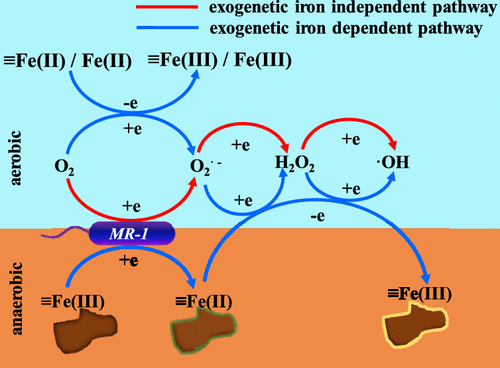当前位置:
X-MOL 学术
›
Environ. Sci. Technol.
›
论文详情
Our official English website, www.x-mol.net, welcomes your
feedback! (Note: you will need to create a separate account there.)
Pathway for the Production of Hydroxyl Radicals during the Microbially Mediated Redox Transformation of Iron (Oxyhydr)oxides.
Environmental Science & Technology ( IF 10.8 ) Pub Date : 2020-01-09 , DOI: 10.1021/acs.est.9b06220
Ruixia Han 1, 2 , Jitao Lv 1 , Zaoquan Huang 1, 2 , Suhuan Zhang 1, 2 , Shuzhen Zhang 1, 2
Environmental Science & Technology ( IF 10.8 ) Pub Date : 2020-01-09 , DOI: 10.1021/acs.est.9b06220
Ruixia Han 1, 2 , Jitao Lv 1 , Zaoquan Huang 1, 2 , Suhuan Zhang 1, 2 , Shuzhen Zhang 1, 2
Affiliation

|
The reduction of ferric iron (Fe(III)) to ferrous iron (Fe(II)) by dissimilatory iron-reducing bacteria is widespread in anaerobic environments. The oxidation of Fe(II) in aerobic environments has been found to produce hydroxyl radicals (•OH); however, the role of iron-reducing bacteria in the process has not been well understood. Here, Shewanella oneidensis MR-1-mediated redox transformation of four typical iron (oxyhydr)oxides and the production of reactive oxygen species were investigated. The results showed that the production of •OH was mainly determined by the insoluble Fe(II) formed during microbially mediated reduction and also mediated by the mineralogical phase. Moreover, this study for the first time observed the exogenetic iron-independent production of •OH by S. oneidensis MR-1, and the integrated pathway of •OH generation during the iron redox process was revealed. Superoxide (O2•-) was indicated as a key intermediate species that was produced by both abiotic and biotic pathways, and •OH was generated by both the exogenetic iron-dependent Fenton-like reaction and exogenetic iron-independent pathways. S. oneidensis MR-1 played a pivotal role in both the reduction of Fe(III) and the production of O2•-. These findings contribute substantially to our understanding of the generation mechanism of reactive oxygen species at oxidation-reduction boundaries in the environment.
中文翻译:

在微生物介导的氧化铁氧化过程中产生羟自由基的途径。
通过异化还原铁细菌将三价铁(Fe(III))还原为二价铁(Fe(II))在厌氧环境中十分普遍。已发现在有氧环境中氧化Fe(II)会产生羟基(•OH);然而,还原铁细菌在该过程中的作用尚未得到很好的理解。在这里,研究了印度希瓦氏菌(Shewanella oneidensis)MR-1介导的四种典型氧化铁(羟基氧化物)的氧化还原转化和活性氧的产生。结果表明,•OH的产生主要由微生物介导的还原过程中形成的不溶性Fe(II)决定,也由矿物相介导。此外,本研究首次观察到沙门氏菌MR-1的外源铁非依赖性•OH的产生,揭示了铁氧化还原过程中•OH生成的整合途径。超氧化物(O2•-)被认为是通过非生物途径和生物途径产生的关键中间物种,而•OH是通过外源铁依赖性Fenton样反应和外源铁非依赖性途径产生的。沙门氏菌MR-1在还原Fe(III)和O2•-的产生中起着关键作用。这些发现大大有助于我们对环境中氧化还原边界处活性氧物种生成机理的理解。•OH是通过外源铁依赖性Fenton样反应和外源铁非依赖性途径生成的。沙门氏菌MR-1在还原Fe(III)和O2•-的产生中起着关键作用。这些发现大大有助于我们对环境中氧化还原边界处活性氧物种生成机理的理解。•OH是通过外源铁依赖性Fenton样反应和外源铁非依赖性途径生成的。沙门氏菌MR-1在还原Fe(III)和O2•-的产生中起着关键作用。这些发现大大有助于我们对环境中氧化还原边界处活性氧物种生成机理的理解。
更新日期:2020-01-10
中文翻译:

在微生物介导的氧化铁氧化过程中产生羟自由基的途径。
通过异化还原铁细菌将三价铁(Fe(III))还原为二价铁(Fe(II))在厌氧环境中十分普遍。已发现在有氧环境中氧化Fe(II)会产生羟基(•OH);然而,还原铁细菌在该过程中的作用尚未得到很好的理解。在这里,研究了印度希瓦氏菌(Shewanella oneidensis)MR-1介导的四种典型氧化铁(羟基氧化物)的氧化还原转化和活性氧的产生。结果表明,•OH的产生主要由微生物介导的还原过程中形成的不溶性Fe(II)决定,也由矿物相介导。此外,本研究首次观察到沙门氏菌MR-1的外源铁非依赖性•OH的产生,揭示了铁氧化还原过程中•OH生成的整合途径。超氧化物(O2•-)被认为是通过非生物途径和生物途径产生的关键中间物种,而•OH是通过外源铁依赖性Fenton样反应和外源铁非依赖性途径产生的。沙门氏菌MR-1在还原Fe(III)和O2•-的产生中起着关键作用。这些发现大大有助于我们对环境中氧化还原边界处活性氧物种生成机理的理解。•OH是通过外源铁依赖性Fenton样反应和外源铁非依赖性途径生成的。沙门氏菌MR-1在还原Fe(III)和O2•-的产生中起着关键作用。这些发现大大有助于我们对环境中氧化还原边界处活性氧物种生成机理的理解。•OH是通过外源铁依赖性Fenton样反应和外源铁非依赖性途径生成的。沙门氏菌MR-1在还原Fe(III)和O2•-的产生中起着关键作用。这些发现大大有助于我们对环境中氧化还原边界处活性氧物种生成机理的理解。

































 京公网安备 11010802027423号
京公网安备 11010802027423号